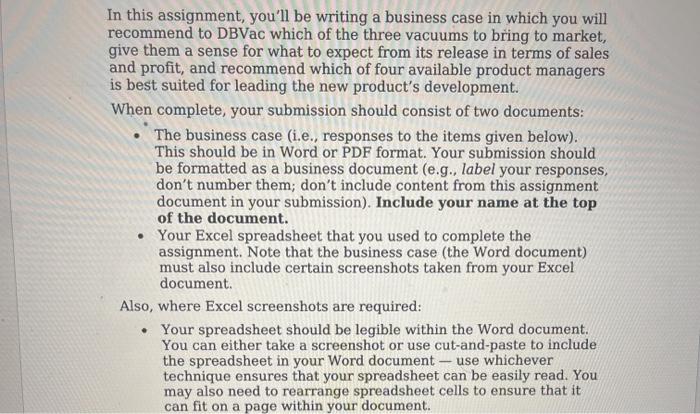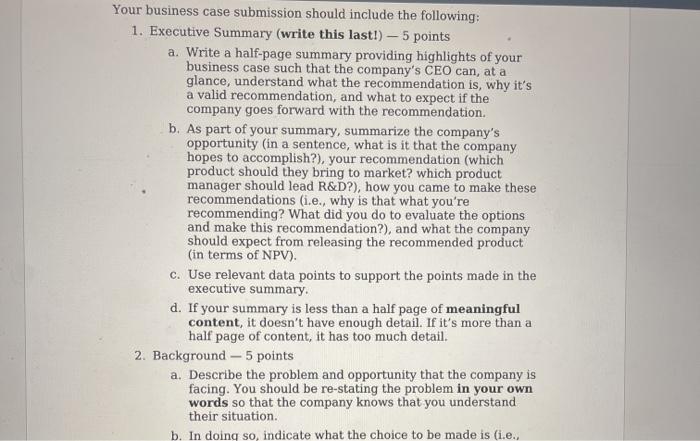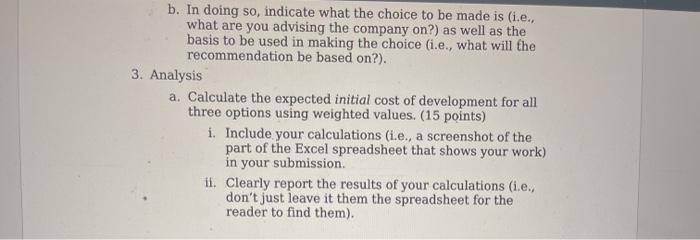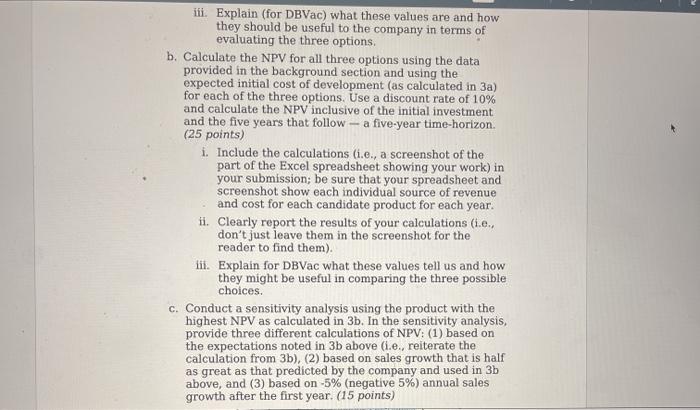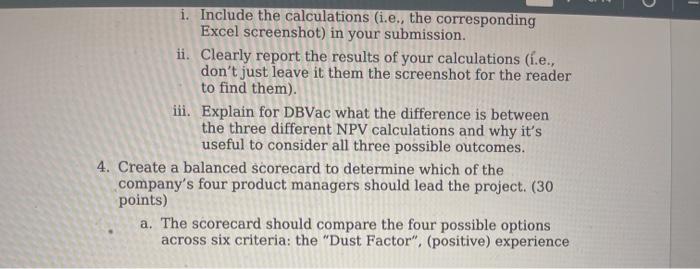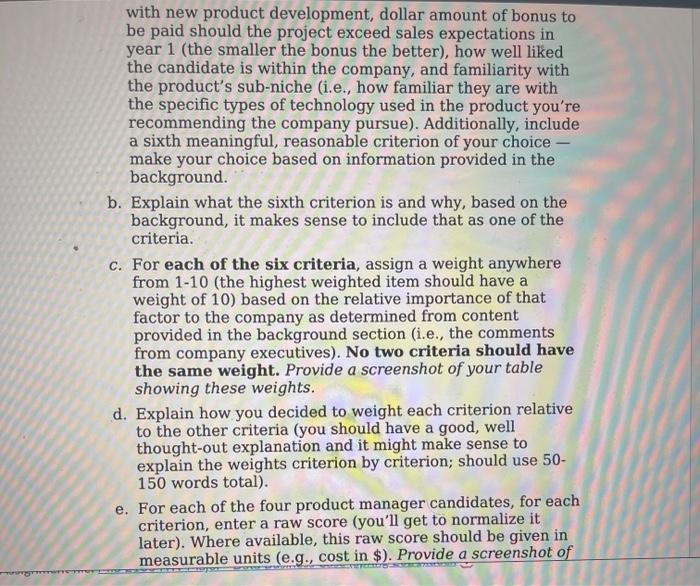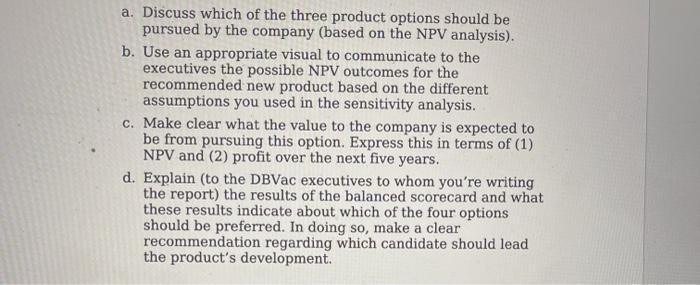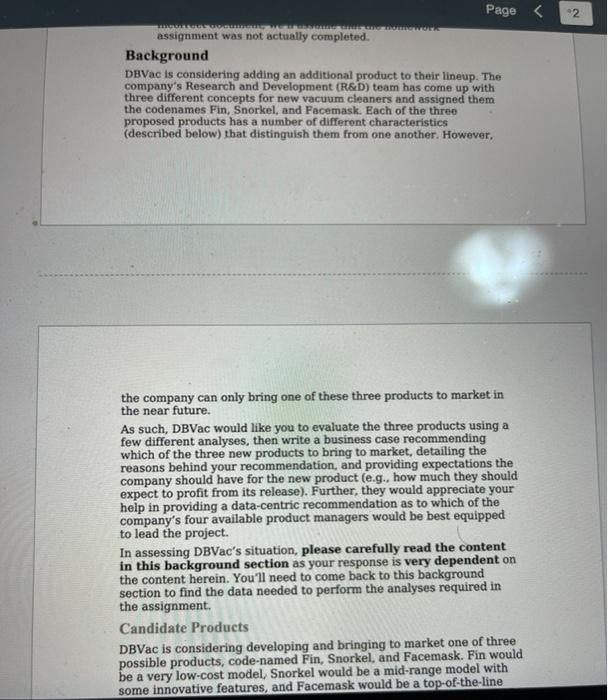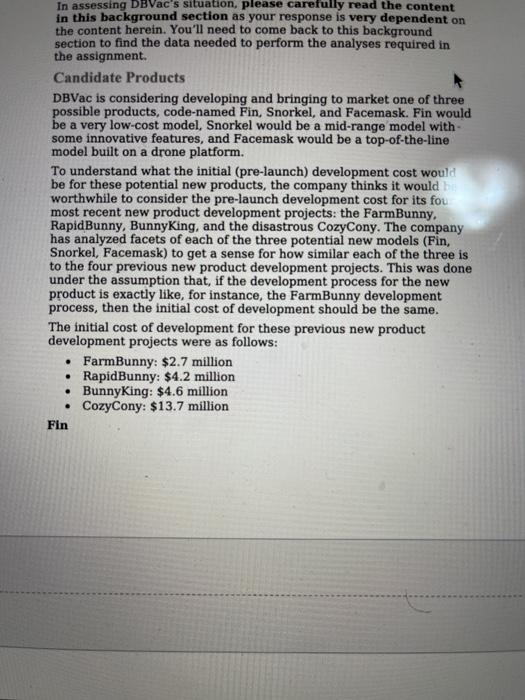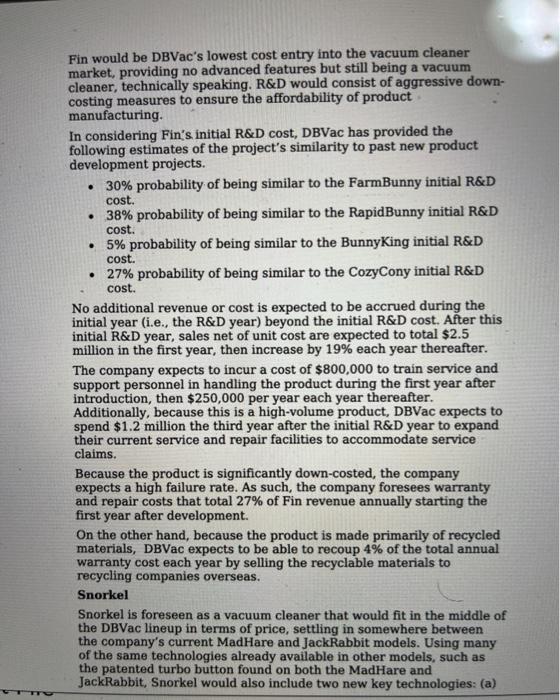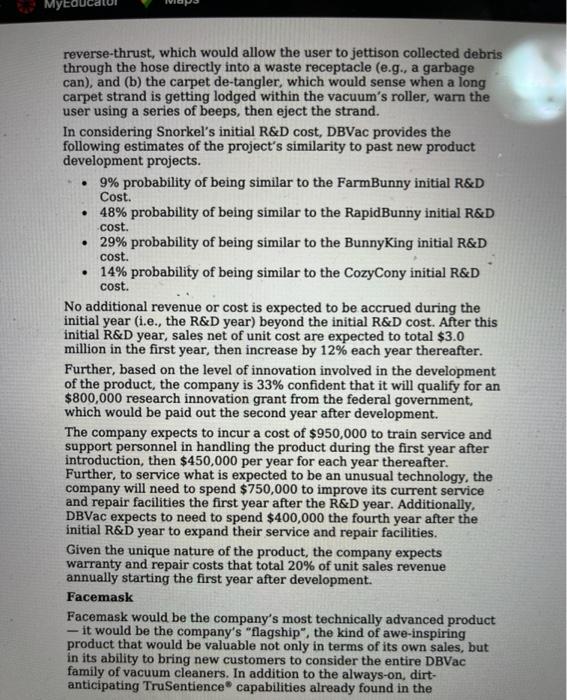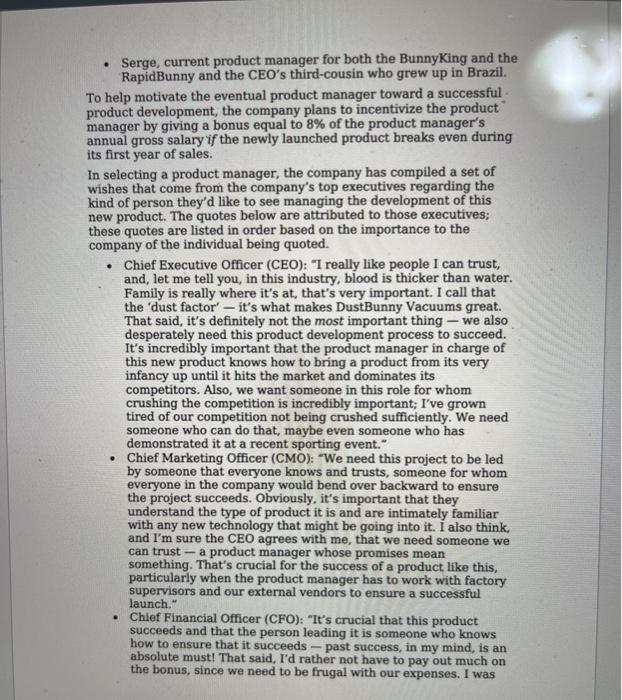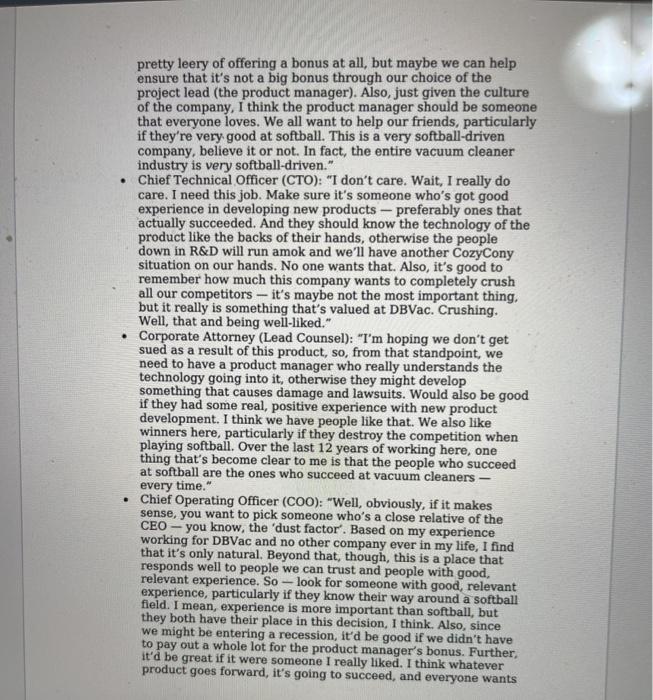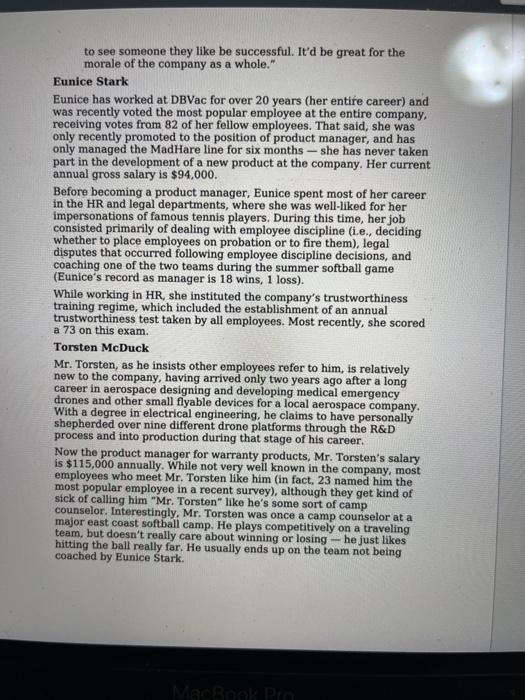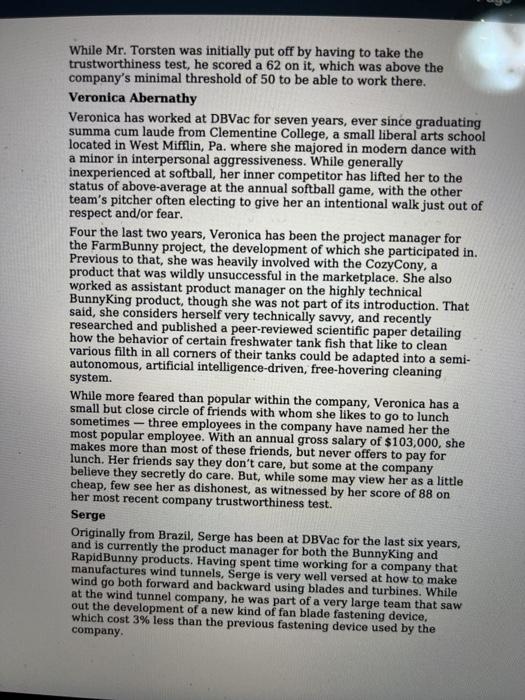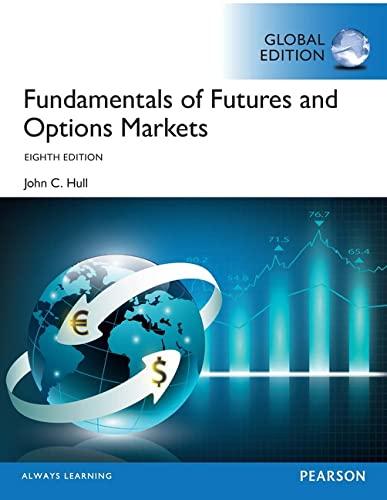In this assignment, you'll be writing a business case in which you will recommend to DBVac which of the three vacuums to bring to market, give them a sense for what to expect from its release in terms of sales and profit, and recommend which of four available product managers is best suited for leading the new product's development. When complete, your submission should consist of two documents: The business case (i.e., responses to the items given below). This should be in Word or PDF format. Your submission should be formatted as a business document (e.g., label your responses, don't number them; don't include content from this assignment document in your submission). Include your name at the top of the document. Your Excel spreadsheet that you used to complete the assignment. Note that the business case (the Word document) must also include certain screenshots taken from your Excel document. Also, where Excel screenshots are required: Your spreadsheet should be legible within the Word document. You can either take a screenshot or use cut-and-paste to include the spreadsheet in your Word document-use whichever technique ensures that your spreadsheet can be easily read. You may also need to rearrange spreadsheet cells to ensure that it can fit on a page within your document. Calculations in your spreadsheet should reference cells (rather than having numerical values hard-coded into the cell where the calculation is being performed). Your spreadsheet screenshots included in the business case should show the cells containing these values (similar to what was demonstrated in class). Your business case submission should include the following: 1. Executive Summary (write this last!) - 5 points a. Write a half-page summary providing highlights of your business case such that the company's CEO can, at a glance, understand what the recommendation is, why it's a valid recommendation, and what to expect if the company goes forward with the recommendation. b. As part of your summary, summarize the company's opportunity (in a sentence, what is it that the company hopes to accomplish?), your recommendation (which product should they bring to market? which product manager should lead R&D?), how you came to make these recommendations (i.e., why is that what you're recommending? What did you do to evaluate the options and make this recommendation?), and what the company should expect from releasing the recommended product (in terms of NPV). c. Use relevant data points to support the points made in the executive summary d. If your summary is less than a half page of meaningful content, it doesn't have enough detail. If it's more than a half page of content, it has too much detail. 2. Background 5 points a. Describe the problem and opportunity that the company is facing. You should be re-stating the problem in your own words so that the company knows that you understand their situation. b. In doing so, indicate what the choice to be made is (i.e. iii. Explain (for DBVac) what these values are and how they should be useful to the company in terms of evaluating the three options. b. Calculate the NPV for all three options using the data provided in the background section and using the expected initial cost of development (as calculated in 3a) for each of the three options. Use a discount rate of 10% and calculate the NPV inclusive of the initial investment and the five years that follow -- a five-year time-horizon (25 points) i. Include the calculations (1.e., a screenshot of the part of the Excel spreadsheet showing your work) in your submission; be sure that your spreadsheet and screenshot show each individual source of revenue and cost for each candidate product for each year. ii. Clearly report the results of your calculations (ie.. don't just leave them in the screenshot for the reader to find them). iii. Explain for DBVac what these values tell us and how they might be useful in comparing the three possible choices. C. Conduct a sensitivity analysis using the product with the highest NPV as calculated in 3b. In the sensitivity analysis, provide three different calculations of NPV: (1) based on the expectations noted in 3b above (1.e., reiterate the calculation from 3b), (2) based on sales growth that is half as great as that predicted by the company and used in 3b above, and (3) based on -5% (negative 5%) annual sales growth after the first year. (15 points) i. Include the calculations (i.e., the corresponding Excel screenshot) in your submission. ii. Clearly report the results of your calculations (.e., don't just leave it them the screenshot for the reader to find them). iii. Explain for DBVac what the difference is between the three different NPV calculations and why it's useful to consider all three possible outcomes. 4. Create a balanced Scorecard to determine which of the company's four product managers should lead the project. (30 points) a. The scorecard should compare the four possible options across six criteria: the "Dust Factor", (positive) experience with new product development, dollar amount of bonus to be paid should the project exceed sales expectations in year 1 (the smaller the bonus the better), how well liked the candidate is within the company, and familiarity with the product's sub-niche (i.e., how familiar they are with the specific types of technology used in the product you're recommending the company pursue). Additionally, include a sixth meaningful, reasonable criterion of your choice - make your choice based on information provided in the background. b. Explain what the sixth criterion is and why, based on the background, it makes sense to include that as one of the criteria. c. For each of the six criteria, assign a weight anywhere from 1-10 (the highest weighted item should have a weight of 10) based on the relative importance of that factor to the company as determined from content provided in the background section (i.e., the comments from company executives). No two criteria should have the same weight. Provide a screenshot of your table showing these weights. d. Explain how you decided to weight each criterion relative to the other criteria (you should have a good, well thought-out explanation and it might make sense to explain the weights criterion by criterion; should use 50- 150 words total). e. For each of the four product manager candidates, for each criterion, enter a raw score (you'll get to normalize it later). Where available, this raw score should be given in measurable units (e.g., cost in $). Provide a screenshot of f. In the same table, calculate the normalized score for each value entered. Use z-transformation normalization to calculate the normalized value. Provide a screenshot of your table. g. Calculate the total balanced scorecard score for each product management candidate using the normalized values and your assigned weights. Provide a screenshot of your table(s). h. Report these final scores in your business case (don't just leave them in the screenshot for the reader to find). 5. Recommendation (10 points) a. Discuss which of the three product options should be pursued by the company (based on the NPV analysis). b. Use an appropriate visual to communicate to the executives the possible NPV outcomes for the recommended new product based on the different assumptions you used in the sensitivity analysis. c. Make clear what the value to the company is expected to be from pursuing this option. Express this in terms of (1) NPV and (2) profit over the next five years. d. Explain (to the DBVac executives to whom you're writing the report) the results of the balanced Scorecard and what these results indicate about which of the four options should be preferred. In doing so, make a clear recommendation regarding which candidate should lead the product's development. In assessing DBVac's situation, please carefully read the content in this background section as your response is very dependent on the content herein. You'll need to come back to this background section to find the data needed to perform the analyses required in the assignment. Candidate Products DBVac is considering developing and bringing to market one of three possible products, code-named Fin, Snorkel, and Facemask. Fin would be a very low-cost model, Snorkel would be a mid-range model with some innovative features, and Facemask would be a top-of-the-line model built on a drone platform. To understand what the initial (pre-launch) development cost would be for these potential new products, the company thinks it would worthwhile to consider the pre-launch development cost for its fou most recent new product development projects: the FarmBunny, RapidBunny, Bunny King, and the disastrous CozyCony. The company has analyzed facets of each of the three potential new models (Fin, Snorkel, Facemask) to get a sense for how similar each of the three is to the four previous new product development projects. This was done under the assumption that, if the development process for the new product is exactly like, for instance, the FarmBunny development process, then the initial cost of development should be the same. The initial cost of development for these previous new product development projects were as follows: FarmBunny: $2.7 million RapidBunny: $4.2 million Bunny King: $4.6 million CozyCony: $13.7 million Fin . Fin would be DBVac's lowest cost entry into the vacuum cleaner market, providing no advanced features but still being a vacuum cleaner, technically speaking. R&D would consist of aggressive down- costing measures to ensure the affordability of product manufacturing In considering Fin's initial R&D cost, DBVac has provided the following estimates of the project's similarity to past new product development projects. 30% probability of being similar to the FarmBunny initial R&D cost. 38% probability of being similar to the RapidBunny initial R&D cost. 5% probability of being similar to the Bunny King initial R&D cost. 27% probability of being similar to the CozyCony initial R&D cost. No additional revenue or cost is expected to be accrued during the initial year (i.e., the R&D year) beyond the initial R&D cost. After this initial R&D year, sales net of unit cost are expected to total $2.5 million in the first year, then increase by 19% each year thereafter. The company expects to incur a cost of $800,000 to train service and support personnel in handling the product during the first year after introduction, then $250,000 per year each year thereafter. Additionally, because this is a high-volume product, DBVac expects to spend $1.2 million the third year after the initial R&D year to expand their current service and repair facilities to accommodate service claims. Because the product is significantly down-costed, the company expects a high failure rate. As such, the company foresees warranty and repair costs that total 27% of Fin revenue annually starting the first year after development. On the other hand, because the product is made primarily of recycled materials, DBVac expects to be able to recoup 4% of the total annual warranty cost each year by selling the recyclable materials to recycling companies overseas. Snorkel Snorkel is foreseen as a vacuum cleaner that would fit in the middle of the DBVac lineup in terms of price, settling in somewhere between the company's current Mad Hare and Jack Rabbit models. Using many of the same technologies already available in other models, such as the patented turbo button found on both the MadHare and Jack Rabbit, Snorkel would also include two new key technologies: (a) reverse-thrust, which would allow the user to jettison collected debris through the hose directly into a waste receptacle (e.g., a garbage can), and (b) the carpet de-tangler, which would sense when a long carpet strand is getting lodged within the vacuum's roller, warn the user using a series of beeps, then eject the strand. In considering Snorkel's initial R&D cost, DBVac provides the following estimates of the project's similarity to past new product development projects. 9% probability of being similar to the FarmBunny initial R&D Cost. 48% probability of being similar to the RapidBunny initial R&D cost. 29% probability of being similar to the BunnyKing initial R&D cost. 14% probability of being similar to the CozyCony initial R&D cost. No additional revenue or cost is expected to be accrued during the initial year (i.e., the R&D year) beyond the initial R&D cost. After this initial R&D year, sales net of unit cost are expected to total $3.0 million in the first year, then increase by 12% each year thereafter. Further, based on the level of innovation involved in the development of the product, the company is 33% confident that it will qualify for an $800,000 research innovation grant from the federal government, which would be paid out the second year after development. The company expects to incur a cost of $950,000 to train service and support personnel in handling the product during the first year after introduction, then $450,000 per year for each year thereafter. Further, to service what is expected to be an unusual technology, the company will need to spend $750,000 to improve its current service and repair facilities the first year after the R&D year. Additionally, DBVac expects to need to spend $400,000 the fourth year after the initial R&D year to expand their service and repair facilities. Given the unique nature of the product, the company expects warranty and repair costs that total 20% of unit sales revenue annually starting the first year after development. Facemask Facemask would be the company's most technically advanced product - it would be the company's "flagship", the kind of awe-inspiring product that would be valuable not only in terms of its own sales, but in its ability to bring new customers to consider the entire DBVac family of vacuum cleaners. In addition to the always-on, dirt- anticipating TruSentience capabilities already found in the company's Bunny King model, Facemask would work in three dimensions. Incorporating military-grade drone technology, Facemask would be able to fly through the household, cleaning window coverings and crown moldings as needed and could even capture dust and dirt mid-air before it has a chance to land on things. In considering Facemask's initial R&D cost, DBVac provides the following estimates of the project's similarity to past new product development projects. 2% probability of being similar to the FarmBunny initial R&D Cost. 39% probability of being similar to the RapidBunny initial R&D cost. 45% probability of being similar to the Bunny King initial R&D cost. 14% probability of being similar to the CozyCony initial R&D cost. No additional revenue or cost is expected to be accrued during the initial year (i.e., the R&D year) beyond the initial R&D cost. After this initial R&D year, sales net of unit cost are expected to total $1.9 million in the first year, then increase by 20% each year thereafter. Further, based on the level of innovation involved in the development of the product, the company is 100% confident that it will qualify for an $800,000 research innovation grant from the federal government, which would be paid out the second year after development. The company expects to incur a cost of $500,000 to train service, support, and repair personnel in handling the product during the first year after introduction, then $240,000 per year for each year thereafter. Finally, the company expects warranty and repair costs that total 16% of sales revenue annually starting the first year after development. Candidate Product Managers In addition to identifying which of the three products should be taken forward and developed, DBVac wants to know which of four product managers is best suited to guide the product through development and into the marketplace. The company is considering four candidates: Eunice Stark, current product manager for the MadHare and the CEO's sister. Torsten McDuck, current product manager for warranty products and the CEO's son by a previous marriage. Veronica Abernathy, current product manager for the FarmBunny and the CEO's cousin. . . . Serge, current product manager for both the Bunny King and the RapidBunny and the CEO's third-cousin who grew up in Brazil. To help motivate the eventual product manager toward a successful product development, the company plans to incentivize the product manager by giving a bonus equal to 8% of the product manager's annual gross salary if the newly launched product breaks even during its first year of sales. In selecting a product manager, the company has compiled a set of wishes that come from the company's top executives regarding the kind of person they'd like to see managing the development of this new product. The quotes below are attributed to those executives; these quotes are listed in order based on the importance to the company of the individual being quoted. Chief Executive Officer (CEO): "I really like people I can trust, and, let me tell you, in this industry, blood is thicker than water. Family is really where it's at, that's very important. I call that the 'dust factor' - it's what makes DustBunny Vacuums great. That said, it's definitely not the most important thing - we also desperately need this product development process to succeed. It's incredibly important that the product manager in charge of this new product knows how to bring a product from its very infancy up until it hits the market and dominates its competitors. Also, we want someone in this role for whom crushing the competition is incredibly important; I've grown tired of our competition not being crushed sufficiently. We need someone who can do that, maybe even someone who has demonstrated it at a recent sporting event." Chief Marketing Officer (CMO): "We need this project to be led by someone that everyone knows and trusts, someone for whom everyone in the company would bend over backward to ensure the project succeeds. Obviously, it's important that they understand the type of product it is and are intimately familiar with any new technology that might be going into it. I also think, and I'm sure the CEO agrees with me, that we need someone we can trust - a product manager whose promises mean something. That's crucial for the success of a product like this, particularly when the product manager has to work with factory supervisors and our external vendors to ensure a successful launch." Chief Financial Officer (CFO): "It's crucial that this product succeeds and that the person leading it is someone who knows how to ensure that it succeeds - past success, in my mind, is an absolute must! That said, I'd rather not have to pay out much on the bonus, since we need to be frugal with our expenses. I was . pretty leery of offering a bonus at all, but maybe we can help ensure that it's not a big bonus through our choice of the project lead (the product manager). Also, just given the culture of the company, I think the product manager should be someone that everyone loves. We all want to help our friends, particularly if they're very good at softball. This is a very softball-driven company, believe it or not. In fact, the entire vacuum cleaner industry is very softball-driven." Chief Technical Officer (CTO): "I don't care. Wait, I really do care. I need this job. Make sure it's someone who's got good experience in developing new products - preferably ones that actually succeeded. And they should know the technology of the product like the backs of their hands, otherwise the people down in R&D will run amok and we'll have another CozyCony situation on our hands. No one wants that. Also, it's good to remember how much this company wants to completely crush all our competitors - it's maybe not the most important thing, but it really is something that's valued at DBVac. Crushing. Well, that and being well-liked." Corporate Attorney (Lead Counsel): "I'm hoping we don't get sued as a result of this product, so, from that standpoint, we need to have a product manager who really understands the technology going into it, otherwise they might develop something that causes damage and lawsuits. Would also be good if they had some real, positive experience with new product development. I think we have people like that. We also like winners here, particularly if they destroy the competition when playing softball. Over the last 12 years of working here, one thing that's become clear to me is that the people who succeed at softball are the ones who succeed at vacuum cleaners - every time." Chief Operating Officer (COO): "Well, obviously, if it makes sense, you want to pick someone who's a close relative of the CEO - you know, the 'dust factor'. Based on my experience working for DBVac and no other company ever in my life, I find that it's only natural. Beyond that, though, this is a place that responds well to people we can trust and people with good, relevant experience. So - look for someone with good, relevant experience, particularly if they know their way around a softball field. I mean, experience is more important than softball, but they both have their place in this decision, I think. Also, since we might be entering a recession, it'd be good if we didn't have to pay out a whole lot for the product manager's bonus. Further, it'd be great if it were someone I really liked. I think whatever product goes forward, it's going to succeed, and everyone wants . While Mr. Torsten was initially put off by having to take the trustworthiness test, he scored a 62 on it, which was above the company's minimal threshold of 50 to be able to work there. Veronica Abernathy Veronica has worked at DBVac for seven years, ever since graduating summa cum laude from Clementine College, a small liberal arts school located in West Mifflin, Pa, where she majored in modern dance with a minor in interpersonal aggressiveness. While generally inexperienced at softball, her inner competitor has lifted her to the status of above-average at the annual softball game, with the other team's pitcher often electing to give her an intentional walk just out of respect and/or fear. Four the last two years, Veronica has been the project manager for the FarmBunny project, the development of which she participated in. Previous to that, she was heavily involved with the CozyCony, a product that was wildly unsuccessful in the marketplace. She also worked as assistant product manager on the highly technical Bunny King product, though she was not part of its introduction. That said, she considers herself very technically savvy, and recently researched and published a peer-reviewed scientific paper detailing how the behavior of certain freshwater tank fish that like to clean various filth in all corners of their tanks could be adapted into a semi- autonomous, artificial intelligence-driven, free-hovering cleaning system. While more feared than popular within the company, Veronica has a small but close circle of friends with whom she likes to go to lunch sometimes - three employees in the company have named her the most popular employee. With an annual gross salary of $103,000, she makes more than most of these friends, but never offers to pay for lunch. Her friends say they don't care, but some at the company believe they secretly do care. But, while some may view her as a little cheap, few see her as dishonest, as witnessed by her score of 88 on her most recent company trustworthiness test. Serge Originally from Brazil, Serge has been at DBVac for the last six years, and is currently the product manager for both the BunnyKing and RapidBunny products. Having spent time working for a company that manufactures wind tunnels, Serge is very well versed at how to make wind go both forward and backward using blades and turbines. While at the wind tunnel company, he was part of a very large team that saw out the development of a new kind of fan blade fastening device, which cost 3% less than the previous fastening device used by the company. Serge is well-liked by almost everyone inside the company - 60 of them named him the most popular employee -- and is considered by the HR department to be very trustworthy, having scored a 77 on the trustworthiness test. His love of beaches and small dogs endears him to pretty much everyone, not including those who really just adamantly dislike small dogs. Of course, it also helps his popularity that he makes only a relatively modest salary of $70,000, despite the fact that he manages twice as many products as any other product manager. While Serge doesn't mind crushing the competition, he isn't well versed in American sports, and thus typically (and controversially) opts out of the annual company softball game. In this assignment, you'll be writing a business case in which you will recommend to DBVac which of the three vacuums to bring to market, give them a sense for what to expect from its release in terms of sales and profit, and recommend which of four available product managers is best suited for leading the new product's development. When complete, your submission should consist of two documents: The business case (i.e., responses to the items given below). This should be in Word or PDF format. Your submission should be formatted as a business document (e.g., label your responses, don't number them; don't include content from this assignment document in your submission). Include your name at the top of the document. Your Excel spreadsheet that you used to complete the assignment. Note that the business case (the Word document) must also include certain screenshots taken from your Excel document. Also, where Excel screenshots are required: Your spreadsheet should be legible within the Word document. You can either take a screenshot or use cut-and-paste to include the spreadsheet in your Word document-use whichever technique ensures that your spreadsheet can be easily read. You may also need to rearrange spreadsheet cells to ensure that it can fit on a page within your document. Calculations in your spreadsheet should reference cells (rather than having numerical values hard-coded into the cell where the calculation is being performed). Your spreadsheet screenshots included in the business case should show the cells containing these values (similar to what was demonstrated in class). Your business case submission should include the following: 1. Executive Summary (write this last!) - 5 points a. Write a half-page summary providing highlights of your business case such that the company's CEO can, at a glance, understand what the recommendation is, why it's a valid recommendation, and what to expect if the company goes forward with the recommendation. b. As part of your summary, summarize the company's opportunity (in a sentence, what is it that the company hopes to accomplish?), your recommendation (which product should they bring to market? which product manager should lead R&D?), how you came to make these recommendations (i.e., why is that what you're recommending? What did you do to evaluate the options and make this recommendation?), and what the company should expect from releasing the recommended product (in terms of NPV). c. Use relevant data points to support the points made in the executive summary d. If your summary is less than a half page of meaningful content, it doesn't have enough detail. If it's more than a half page of content, it has too much detail. 2. Background 5 points a. Describe the problem and opportunity that the company is facing. You should be re-stating the problem in your own words so that the company knows that you understand their situation. b. In doing so, indicate what the choice to be made is (i.e. iii. Explain (for DBVac) what these values are and how they should be useful to the company in terms of evaluating the three options. b. Calculate the NPV for all three options using the data provided in the background section and using the expected initial cost of development (as calculated in 3a) for each of the three options. Use a discount rate of 10% and calculate the NPV inclusive of the initial investment and the five years that follow -- a five-year time-horizon (25 points) i. Include the calculations (1.e., a screenshot of the part of the Excel spreadsheet showing your work) in your submission; be sure that your spreadsheet and screenshot show each individual source of revenue and cost for each candidate product for each year. ii. Clearly report the results of your calculations (ie.. don't just leave them in the screenshot for the reader to find them). iii. Explain for DBVac what these values tell us and how they might be useful in comparing the three possible choices. C. Conduct a sensitivity analysis using the product with the highest NPV as calculated in 3b. In the sensitivity analysis, provide three different calculations of NPV: (1) based on the expectations noted in 3b above (1.e., reiterate the calculation from 3b), (2) based on sales growth that is half as great as that predicted by the company and used in 3b above, and (3) based on -5% (negative 5%) annual sales growth after the first year. (15 points) i. Include the calculations (i.e., the corresponding Excel screenshot) in your submission. ii. Clearly report the results of your calculations (.e., don't just leave it them the screenshot for the reader to find them). iii. Explain for DBVac what the difference is between the three different NPV calculations and why it's useful to consider all three possible outcomes. 4. Create a balanced Scorecard to determine which of the company's four product managers should lead the project. (30 points) a. The scorecard should compare the four possible options across six criteria: the "Dust Factor", (positive) experience with new product development, dollar amount of bonus to be paid should the project exceed sales expectations in year 1 (the smaller the bonus the better), how well liked the candidate is within the company, and familiarity with the product's sub-niche (i.e., how familiar they are with the specific types of technology used in the product you're recommending the company pursue). Additionally, include a sixth meaningful, reasonable criterion of your choice - make your choice based on information provided in the background. b. Explain what the sixth criterion is and why, based on the background, it makes sense to include that as one of the criteria. c. For each of the six criteria, assign a weight anywhere from 1-10 (the highest weighted item should have a weight of 10) based on the relative importance of that factor to the company as determined from content provided in the background section (i.e., the comments from company executives). No two criteria should have the same weight. Provide a screenshot of your table showing these weights. d. Explain how you decided to weight each criterion relative to the other criteria (you should have a good, well thought-out explanation and it might make sense to explain the weights criterion by criterion; should use 50- 150 words total). e. For each of the four product manager candidates, for each criterion, enter a raw score (you'll get to normalize it later). Where available, this raw score should be given in measurable units (e.g., cost in $). Provide a screenshot of f. In the same table, calculate the normalized score for each value entered. Use z-transformation normalization to calculate the normalized value. Provide a screenshot of your table. g. Calculate the total balanced scorecard score for each product management candidate using the normalized values and your assigned weights. Provide a screenshot of your table(s). h. Report these final scores in your business case (don't just leave them in the screenshot for the reader to find). 5. Recommendation (10 points) a. Discuss which of the three product options should be pursued by the company (based on the NPV analysis). b. Use an appropriate visual to communicate to the executives the possible NPV outcomes for the recommended new product based on the different assumptions you used in the sensitivity analysis. c. Make clear what the value to the company is expected to be from pursuing this option. Express this in terms of (1) NPV and (2) profit over the next five years. d. Explain (to the DBVac executives to whom you're writing the report) the results of the balanced Scorecard and what these results indicate about which of the four options should be preferred. In doing so, make a clear recommendation regarding which candidate should lead the product's development. In assessing DBVac's situation, please carefully read the content in this background section as your response is very dependent on the content herein. You'll need to come back to this background section to find the data needed to perform the analyses required in the assignment. Candidate Products DBVac is considering developing and bringing to market one of three possible products, code-named Fin, Snorkel, and Facemask. Fin would be a very low-cost model, Snorkel would be a mid-range model with some innovative features, and Facemask would be a top-of-the-line model built on a drone platform. To understand what the initial (pre-launch) development cost would be for these potential new products, the company thinks it would worthwhile to consider the pre-launch development cost for its fou most recent new product development projects: the FarmBunny, RapidBunny, Bunny King, and the disastrous CozyCony. The company has analyzed facets of each of the three potential new models (Fin, Snorkel, Facemask) to get a sense for how similar each of the three is to the four previous new product development projects. This was done under the assumption that, if the development process for the new product is exactly like, for instance, the FarmBunny development process, then the initial cost of development should be the same. The initial cost of development for these previous new product development projects were as follows: FarmBunny: $2.7 million RapidBunny: $4.2 million Bunny King: $4.6 million CozyCony: $13.7 million Fin . Fin would be DBVac's lowest cost entry into the vacuum cleaner market, providing no advanced features but still being a vacuum cleaner, technically speaking. R&D would consist of aggressive down- costing measures to ensure the affordability of product manufacturing In considering Fin's initial R&D cost, DBVac has provided the following estimates of the project's similarity to past new product development projects. 30% probability of being similar to the FarmBunny initial R&D cost. 38% probability of being similar to the RapidBunny initial R&D cost. 5% probability of being similar to the Bunny King initial R&D cost. 27% probability of being similar to the CozyCony initial R&D cost. No additional revenue or cost is expected to be accrued during the initial year (i.e., the R&D year) beyond the initial R&D cost. After this initial R&D year, sales net of unit cost are expected to total $2.5 million in the first year, then increase by 19% each year thereafter. The company expects to incur a cost of $800,000 to train service and support personnel in handling the product during the first year after introduction, then $250,000 per year each year thereafter. Additionally, because this is a high-volume product, DBVac expects to spend $1.2 million the third year after the initial R&D year to expand their current service and repair facilities to accommodate service claims. Because the product is significantly down-costed, the company expects a high failure rate. As such, the company foresees warranty and repair costs that total 27% of Fin revenue annually starting the first year after development. On the other hand, because the product is made primarily of recycled materials, DBVac expects to be able to recoup 4% of the total annual warranty cost each year by selling the recyclable materials to recycling companies overseas. Snorkel Snorkel is foreseen as a vacuum cleaner that would fit in the middle of the DBVac lineup in terms of price, settling in somewhere between the company's current Mad Hare and Jack Rabbit models. Using many of the same technologies already available in other models, such as the patented turbo button found on both the MadHare and Jack Rabbit, Snorkel would also include two new key technologies: (a) reverse-thrust, which would allow the user to jettison collected debris through the hose directly into a waste receptacle (e.g., a garbage can), and (b) the carpet de-tangler, which would sense when a long carpet strand is getting lodged within the vacuum's roller, warn the user using a series of beeps, then eject the strand. In considering Snorkel's initial R&D cost, DBVac provides the following estimates of the project's similarity to past new product development projects. 9% probability of being similar to the FarmBunny initial R&D Cost. 48% probability of being similar to the RapidBunny initial R&D cost. 29% probability of being similar to the BunnyKing initial R&D cost. 14% probability of being similar to the CozyCony initial R&D cost. No additional revenue or cost is expected to be accrued during the initial year (i.e., the R&D year) beyond the initial R&D cost. After this initial R&D year, sales net of unit cost are expected to total $3.0 million in the first year, then increase by 12% each year thereafter. Further, based on the level of innovation involved in the development of the product, the company is 33% confident that it will qualify for an $800,000 research innovation grant from the federal government, which would be paid out the second year after development. The company expects to incur a cost of $950,000 to train service and support personnel in handling the product during the first year after introduction, then $450,000 per year for each year thereafter. Further, to service what is expected to be an unusual technology, the company will need to spend $750,000 to improve its current service and repair facilities the first year after the R&D year. Additionally, DBVac expects to need to spend $400,000 the fourth year after the initial R&D year to expand their service and repair facilities. Given the unique nature of the product, the company expects warranty and repair costs that total 20% of unit sales revenue annually starting the first year after development. Facemask Facemask would be the company's most technically advanced product - it would be the company's "flagship", the kind of awe-inspiring product that would be valuable not only in terms of its own sales, but in its ability to bring new customers to consider the entire DBVac family of vacuum cleaners. In addition to the always-on, dirt- anticipating TruSentience capabilities already found in the company's Bunny King model, Facemask would work in three dimensions. Incorporating military-grade drone technology, Facemask would be able to fly through the household, cleaning window coverings and crown moldings as needed and could even capture dust and dirt mid-air before it has a chance to land on things. In considering Facemask's initial R&D cost, DBVac provides the following estimates of the project's similarity to past new product development projects. 2% probability of being similar to the FarmBunny initial R&D Cost. 39% probability of being similar to the RapidBunny initial R&D cost. 45% probability of being similar to the Bunny King initial R&D cost. 14% probability of being similar to the CozyCony initial R&D cost. No additional revenue or cost is expected to be accrued during the initial year (i.e., the R&D year) beyond the initial R&D cost. After this initial R&D year, sales net of unit cost are expected to total $1.9 million in the first year, then increase by 20% each year thereafter. Further, based on the level of innovation involved in the development of the product, the company is 100% confident that it will qualify for an $800,000 research innovation grant from the federal government, which would be paid out the second year after development. The company expects to incur a cost of $500,000 to train service, support, and repair personnel in handling the product during the first year after introduction, then $240,000 per year for each year thereafter. Finally, the company expects warranty and repair costs that total 16% of sales revenue annually starting the first year after development. Candidate Product Managers In addition to identifying which of the three products should be taken forward and developed, DBVac wants to know which of four product managers is best suited to guide the product through development and into the marketplace. The company is considering four candidates: Eunice Stark, current product manager for the MadHare and the CEO's sister. Torsten McDuck, current product manager for warranty products and the CEO's son by a previous marriage. Veronica Abernathy, current product manager for the FarmBunny and the CEO's cousin. . . . Serge, current product manager for both the Bunny King and the RapidBunny and the CEO's third-cousin who grew up in Brazil. To help motivate the eventual product manager toward a successful product development, the company plans to incentivize the product manager by giving a bonus equal to 8% of the product manager's annual gross salary if the newly launched product breaks even during its first year of sales. In selecting a product manager, the company has compiled a set of wishes that come from the company's top executives regarding the kind of person they'd like to see managing the development of this new product. The quotes below are attributed to those executives; these quotes are listed in order based on the importance to the company of the individual being quoted. Chief Executive Officer (CEO): "I really like people I can trust, and, let me tell you, in this industry, blood is thicker than water. Family is really where it's at, that's very important. I call that the 'dust factor' - it's what makes DustBunny Vacuums great. That said, it's definitely not the most important thing - we also desperately need this product development process to succeed. It's incredibly important that the product manager in charge of this new product knows how to bring a product from its very infancy up until it hits the market and dominates its competitors. Also, we want someone in this role for whom crushing the competition is incredibly important; I've grown tired of our competition not being crushed sufficiently. We need someone who can do that, maybe even someone who has demonstrated it at a recent sporting event." Chief Marketing Officer (CMO): "We need this project to be led by someone that everyone knows and trusts, someone for whom everyone in the company would bend over backward to ensure the project succeeds. Obviously, it's important that they understand the type of product it is and are intimately familiar with any new technology that might be going into it. I also think, and I'm sure the CEO agrees with me, that we need someone we can trust - a product manager whose promises mean something. That's crucial for the success of a product like this, particularly when the product manager has to work with factory supervisors and our external vendors to ensure a successful launch." Chief Financial Officer (CFO): "It's crucial that this product succeeds and that the person leading it is someone who knows how to ensure that it succeeds - past success, in my mind, is an absolute must! That said, I'd rather not have to pay out much on the bonus, since we need to be frugal with our expenses. I was . pretty leery of offering a bonus at all, but maybe we can help ensure that it's not a big bonus through our choice of the project lead (the product manager). Also, just given the culture of the company, I think the product manager should be someone that everyone loves. We all want to help our friends, particularly if they're very good at softball. This is a very softball-driven company, believe it or not. In fact, the entire vacuum cleaner industry is very softball-driven." Chief Technical Officer (CTO): "I don't care. Wait, I really do care. I need this job. Make sure it's someone who's got good experience in developing new products - preferably ones that actually succeeded. And they should know the technology of the product like the backs of their hands, otherwise the people down in R&D will run amok and we'll have another CozyCony situation on our hands. No one wants that. Also, it's good to remember how much this company wants to completely crush all our competitors - it's maybe not the most important thing, but it really is something that's valued at DBVac. Crushing. Well, that and being well-liked." Corporate Attorney (Lead Counsel): "I'm hoping we don't get sued as a result of this product, so, from that standpoint, we need to have a product manager who really understands the technology going into it, otherwise they might develop something that causes damage and lawsuits. Would also be good if they had some real, positive experience with new product development. I think we have people like that. We also like winners here, particularly if they destroy the competition when playing softball. Over the last 12 years of working here, one thing that's become clear to me is that the people who succeed at softball are the ones who succeed at vacuum cleaners - every time." Chief Operating Officer (COO): "Well, obviously, if it makes sense, you want to pick someone who's a close relative of the CEO - you know, the 'dust factor'. Based on my experience working for DBVac and no other company ever in my life, I find that it's only natural. Beyond that, though, this is a place that responds well to people we can trust and people with good, relevant experience. So - look for someone with good, relevant experience, particularly if they know their way around a softball field. I mean, experience is more important than softball, but they both have their place in this decision, I think. Also, since we might be entering a recession, it'd be good if we didn't have to pay out a whole lot for the product manager's bonus. Further, it'd be great if it were someone I really liked. I think whatever product goes forward, it's going to succeed, and everyone wants . While Mr. Torsten was initially put off by having to take the trustworthiness test, he scored a 62 on it, which was above the company's minimal threshold of 50 to be able to work there. Veronica Abernathy Veronica has worked at DBVac for seven years, ever since graduating summa cum laude from Clementine College, a small liberal arts school located in West Mifflin, Pa, where she majored in modern dance with a minor in interpersonal aggressiveness. While generally inexperienced at softball, her inner competitor has lifted her to the status of above-average at the annual softball game, with the other team's pitcher often electing to give her an intentional walk just out of respect and/or fear. Four the last two years, Veronica has been the project manager for the FarmBunny project, the development of which she participated in. Previous to that, she was heavily involved with the CozyCony, a product that was wildly unsuccessful in the marketplace. She also worked as assistant product manager on the highly technical Bunny King product, though she was not part of its introduction. That said, she considers herself very technically savvy, and recently researched and published a peer-reviewed scientific paper detailing how the behavior of certain freshwater tank fish that like to clean various filth in all corners of their tanks could be adapted into a semi- autonomous, artificial intelligence-driven, free-hovering cleaning system. While more feared than popular within the company, Veronica has a small but close circle of friends with whom she likes to go to lunch sometimes - three employees in the company have named her the most popular employee. With an annual gross salary of $103,000, she makes more than most of these friends, but never offers to pay for lunch. Her friends say they don't care, but some at the company believe they secretly do care. But, while some may view her as a little cheap, few see her as dishonest, as witnessed by her score of 88 on her most recent company trustworthiness test. Serge Originally from Brazil, Serge has been at DBVac for the last six years, and is currently the product manager for both the BunnyKing and RapidBunny products. Having spent time working for a company that manufactures wind tunnels, Serge is very well versed at how to make wind go both forward and backward using blades and turbines. While at the wind tunnel company, he was part of a very large team that saw out the development of a new kind of fan blade fastening device, which cost 3% less than the previous fastening device used by the company. Serge is well-liked by almost everyone inside the company - 60 of them named him the most popular employee -- and is considered by the HR department to be very trustworthy, having scored a 77 on the trustworthiness test. His love of beaches and small dogs endears him to pretty much everyone, not including those who really just adamantly dislike small dogs. Of course, it also helps his popularity that he makes only a relatively modest salary of $70,000, despite the fact that he manages twice as many products as any other product manager. While Serge doesn't mind crushing the competition, he isn't well versed in American sports, and thus typically (and controversially) opts out of the annual company softball game
